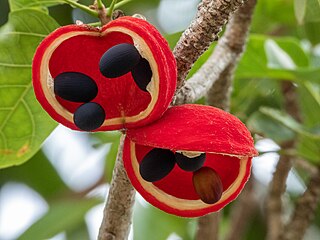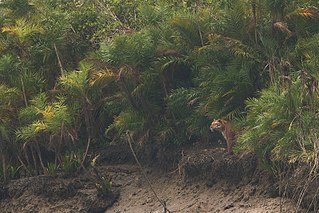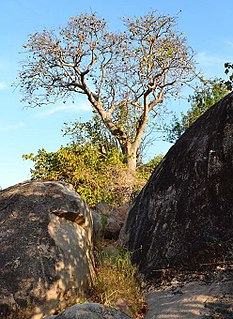
William Roxburgh FRSE FRCPE FLS was a Scottish surgeon and botanist who worked extensively in India, describing species and working on economic botany. He is known as the founding father of Indian botany. He published numerous works on Indian botany, illustrated by careful drawings made by Indian artists and accompanied by taxonomic descriptions of many plant species. Apart from the numerous species that he named, many species were named in his honour by his collaborators.

Sterculia is a genus of flowering plants in the mallow family, Malvaceae: subfamily Sterculioideae. Members of the genus are colloquially known as tropical chestnuts. The scientific name is taken from Sterculius of Roman mythology, who was the god of manure; this is in reference to the unpleasant aroma of the flowers of this genus. Sterculia may be monoecious or dioecious, and flowers unisexual or bisexual.

Sterculia quadrifida, also known as the peanut tree, or red-fruited kurrajong is a small tree that grows in the rainforests, vine thickets, and gallery forests of New Guinea and northern Australia.

Aesculus parviflora, the bottlebrush buckeye, is a species of suckering deciduous shrub in the family Sapindaceae. The species is native to the southeastern United States, where it is found primarily in Alabama and Georgia, with a disjunct population in South Carolina along the Savannah River. Its natural habitat is in mesic forests, on bluffs and in ravines.

The Jardin de l'État, formerly known as the Jardin du Roy, is a historic botanical garden on the island of Réunion, found in the capital Saint-Denis.

Phoenix paludosa, also called the mangrove date palm, is a species of flowering plant in the palm family, indigenous to coastal regions of India, Bangladesh, Myanmar, Thailand, Cambodia, Sumatra, Vietnam and peninsular Malaysia. They are also known as Sea Dates. The trees grow in clusters, to 5 m high, usually forming dense thickets. The leaves are 2 to 3 m long and recurved.

Helicia is a genus of 110 species of trees and shrubs, constituting part of the plant family Proteaceae. They grow naturally in rainforests throughout tropical South and Southeast Asia, including India, Sri Lanka, Indochina, Peninsular Malaysia to New Guinea and as far south as New South Wales.
Horsfieldia parviflora is a species of plant in the family Myristicaceae. It is a tree found in the Moluccas and Singapore.
Kibara coriacea is a plant in the family Monimiaceae. The specific epithet coriacea is from the Latin meaning "leathery", referring to the leaves.

Scleropyrum is a genus of trees in family Santalaceae first described as a genus in 1838. At present, only one species is recognized, although several others are listed as "unresolved," meaning that further research is needed to determine affinities.
Sterculia khasiana was a species of plant in the family Malvaceae. It was an endemic tree of the Khasi Hills in Meghalaya in India. It became extinct due to habitat loss.

Hymenodictyon is a genus of flowering plants in the family Rubiaceae. It has about 30 species. All are native to the Old World. The wood of Hymenodictyon orixense is soft and has limited use, mostly for boxes. The type species for Hymenodictyon is Hymenodictyon orixense.

Synaphea spinulosa is a species of small shrub in the flowering plant family Proteaceae. It is endemic to Western Australia. Together with Acacia truncata, it was the first Australian endemic to be scientifically described and named, and the specimen upon which that description is based is the oldest extant specimen of an Australian plant, and very likely among the first Australian plant specimens ever collected.

Ammannia multiflora, commonly known as many-flower ammannia and jerry-jerry in Victoria, is a species in the family Lythraceae. It is widespread in Asia, tropical and sub-tropical Africa and Australia. It can be found in shallow water and damp heavy soils.

Bruguiera parviflora is a tree in the family Rhizophoraceae. The specific epithet parviflora is from the Latin meaning "small flowers".

Sterculia africana is a deciduous tree, belonging to the genus Sterculia and the family Malvaceae. The species is sometimes called the "mopopaja tree". It is distributed throughout Northeast Africa to Arabia.

Sterculia lanceifolia is a bush/tree species belonging to the genus Sterculia in the family Malvaceae. This species is found in Bangladesh, NE India, China and Indo-China and there are no subspecies listed in the Catalogue of Life.
Dalbergia parviflora is a species of liana found in South East Asia. Its name is kayu laka in Malay and Indonesian, khree in Thai, and in Vietnamese it is trắc hoa nhỏ. The heartwood of the plant is lakawood, an aromatic wood used for incense. The genus Dalbergia is placed in the subfamily Faboideae and tribe Dalbergieae; no subspecies are listed in the Catalogue of Life.

Phyllanthus tenellus is a herbaceous plant in the leafflower family, Phyllanthaceae. It is commonly called Mascarene Island leaf flower as it is native to the Mascarene Islands. It is often a weed in flower beds, gardens, roadsides, and other disturbed areas.

Uvaria macrophylla, also known by its common name large-leaved uvaria, is a species of flowering plant in the family Annonaceae. The species was originally described by William Roxburgh in 1832. The name is a synonym of Uvaria littoralis (Blume) Blume.


















